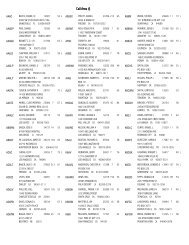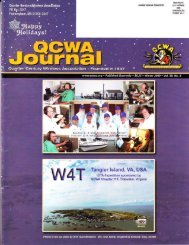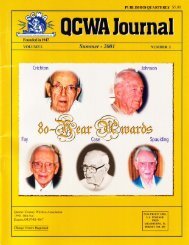ASHLAND, MA PEBMIT NO.7 - Quarter Century Wireless Association
ASHLAND, MA PEBMIT NO.7 - Quarter Century Wireless Association
ASHLAND, MA PEBMIT NO.7 - Quarter Century Wireless Association
Create successful ePaper yourself
Turn your PDF publications into a flip-book with our unique Google optimized e-Paper software.
Q. lbur comrnent regarding incentive lieensing was<br />
so very, very right. Perhaps an incentive to grant<br />
spectrum-based privileges to new licEnsees may have<br />
merit, but to have taken away frcquencies from<br />
those who had previously earned them, is another<br />
thing altogethen I struggle to understand how an<br />
Extra Class - with no telegraphy skills - is entitled to<br />
work telegraphy in the lower 25 KHz of the CW<br />
bands. and yet one who previously earned those<br />
privileges at 13 wpm, and can handle close to 30<br />
wpm is not.<br />
A. Thank you.<br />
Q, We have members ofi our net who are very (oncerned<br />
about the Net Control using our cluh station<br />
call *ign without appending l4 to the call sign. Can<br />
the Trustee allow different Net Control Stations to use<br />
the call sign *naked?"<br />
A. That is the trustee's choice, unless the operator license<br />
class held by the SCO exceeds that of the station licensee,<br />
(see Section 91 .119(e)); or unless the SCO is a recent<br />
upgrade with a CSCE (see Section 97 .119(f)); or unless the<br />
station is transmitting under the reciprocal operating<br />
authority (see Section 97.1 19(g)).<br />
Section 97 .119(c) says that one or more indicators may<br />
be included with the call sign. Each indicator must be separated<br />
from the call sign by the slant mark (/) or by any suitable<br />
word that denotes the slant mark. lf an indicator is<br />
self-assigned (as in your scenario), it must be included<br />
before, after, or both before and after, the call sign. No selfassigned<br />
indicator may conflict with any other indicator<br />
specified by the FCC Rules or with any prefix assigned to<br />
another country.<br />
Q. As the truste€ for our club station, can I use rthat<br />
call sign at my office and in myr car?<br />
A. That decision is the trustee's (that's you). "Use that call<br />
sign" is hamslanguage for taking responsibility for the station<br />
transmitting properly on amateur service spectrum. See<br />
Section 97.5(a).<br />
Q. When linking two local rep€aters (with different<br />
call signs) to better facilitate emergency communiea'<br />
tions, is it permi:sible for each repeater to repeat the<br />
lD from the other?<br />
A. Yes, as long as each station achieves compliance with the<br />
station identification requirement in Sectron 97.119(a) by<br />
transmrtting its assigned call sign as necessary.<br />
ln order to transmit legitimately but one of the call signs<br />
in both station l.D. announcements, one of the two station<br />
licensees would have to transfer physical control of the station<br />
apparatus to the other, per Section 97.5(a). The recipient<br />
would have to accept accountability for the proper<br />
operation of both repeaters.<br />
<strong>Quarter</strong> <strong>Century</strong> <strong>Wireless</strong> Assoclatlon<br />
Q. I am the trustee for a local club repeater. I was<br />
asked by a local rouple if they are permitted to speak<br />
in their native Portuguee on the repeaten My understanding<br />
is that it is allowed so long as they lD every<br />
10 minutes in English, I was then informed that this is<br />
corre(t if communicating sirnplex, but not if communicating<br />
via repeater. My main concern is that neither I<br />
nor any of our eontrol operators speak Portuguese<br />
and therefore cannot maintain control, Right?<br />
A. Right you are. The SCO of the repeater would have to<br />
have some way of determining that any communications<br />
being transmitted - in a language that he or she does not<br />
understand - is compliant with the transmissions authorized<br />
in Section 97.111 and that they do not run afoul of the<br />
transmissions prohibited by Section 97.113. As for the station<br />
identification announcement, Section 97.1 19(bX2) says<br />
that for any FCC-licensed amateur station being identified<br />
by a phone emission, it must be in the English language.<br />
Q. As I understand,it, the 200 watt limitation on 30<br />
meters is dependent upon the dass of operator lice*se<br />
of the station control opcrator. Thsse handy charts<br />
showing bands, emission typesr etc., however, don't<br />
make any such distinrtion. llUhat's the real scoop oil<br />
this?<br />
A. Section 97 .313 codifies our transmitter power standards.<br />
Some of the paragraphs in that section are based upon the<br />
class of license granted to the SCO, but not those pertaining<br />
to the 30 meter band. Paragraph 97.3'13(c)(1)is the<br />
operative requirement. lt says: No station may transmit with<br />
a transmitter power exceeding 200 W PEP on the 10.'10-<br />
10.1 5 MHz segment.<br />
Q. When I aperate from my house in Florida {my permanent<br />
address is in PA). I usa my third district call<br />
sign. We are there no rnore than 4 months at a time. I<br />
have not notified the FCC that nry address is temporal-<br />
Iy in Florida and have used rny call sign without any /4<br />
or /W4 on the end. Should I notifu the FCC of my temporary<br />
address changes even of short duration?<br />
A. Not as long as you can receive mail promptly from the<br />
FCC. Section 97.23 says that each license grant must show<br />
the grantee's correct name and mailing address. The mailing<br />
address must be in an area where the amateur service is<br />
regulated by the FCC and where the grantee can receive<br />
mail delivery by the United States Postal Service.<br />
Q, Do I sign my call as l4 or 1W4?<br />
A. Section 91.119(c) authorizes you to append any selfassigned<br />
indicator as long as it does not conflict with any<br />
other indicator specified by the FCC Rules or with any prefix<br />
assigned to another country.



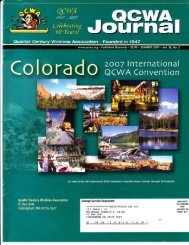
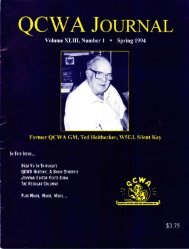
![11{J hI EfifSIt]E I]E - Quarter Century Wireless Association](https://img.yumpu.com/11816560/1/190x245/11j-hi-efifsite-ie-quarter-century-wireless-association.jpg?quality=85)
